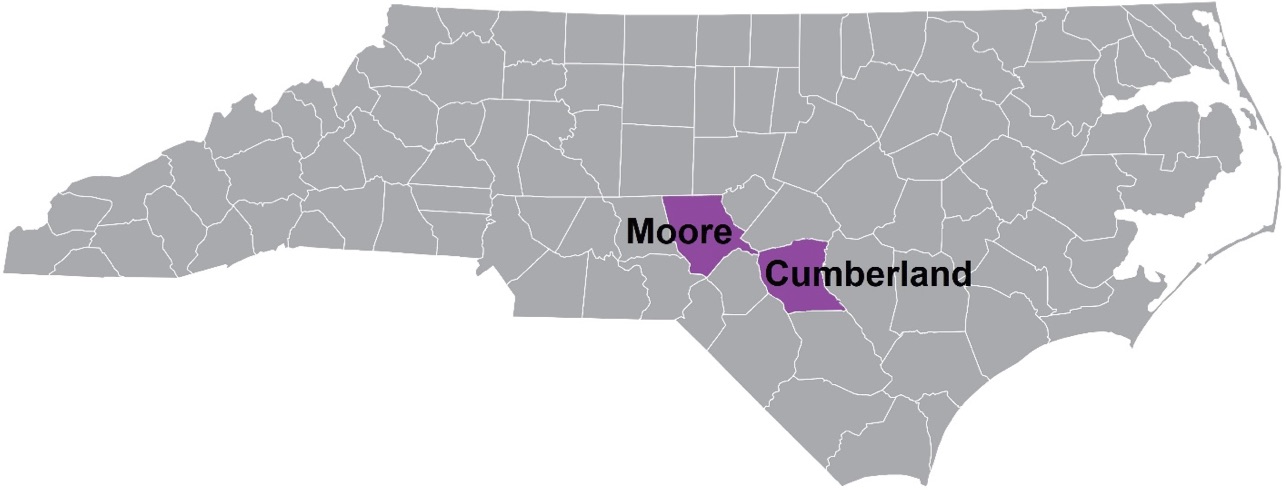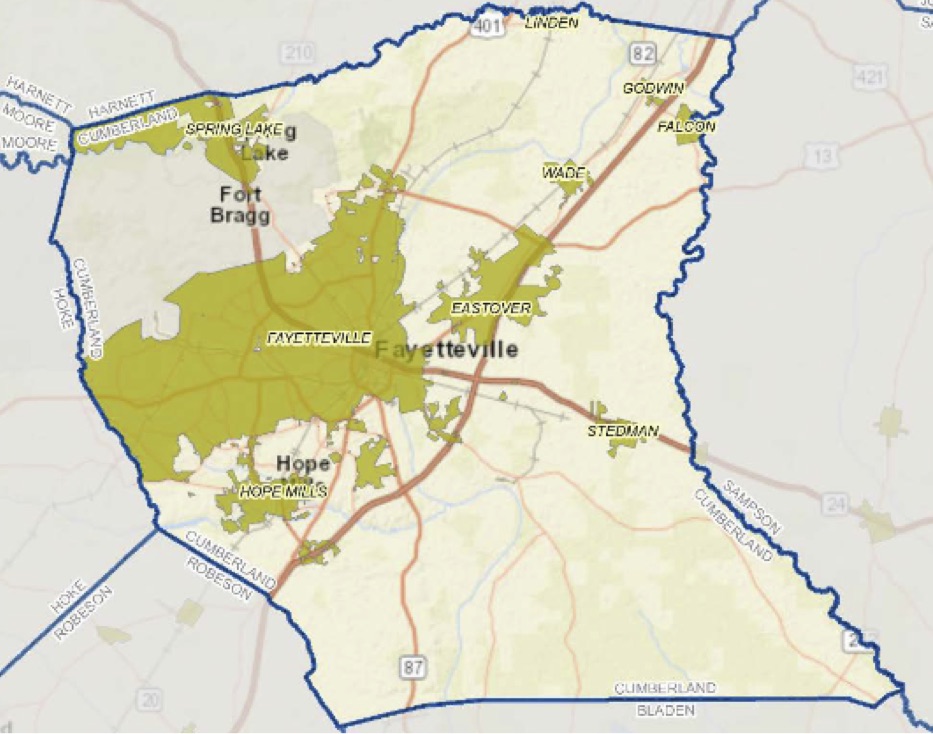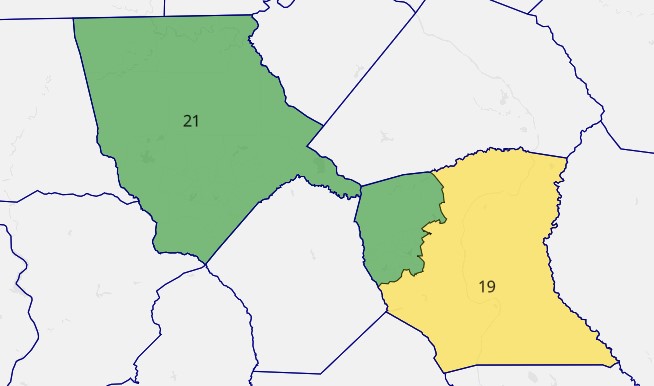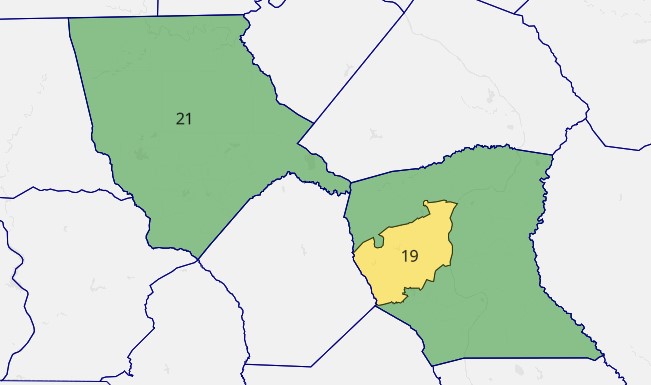- The geography of Cumberland and Moore counties will force legislators to make tough choices when drawing North Carolina Senate districts for them
- Legislators could draw relatively compact districts, but at the expense of splitting Fayetteville
- Keeping Fayetteville together would help North Carolina comply with the Voting Rights Act
This article is part of a limited series of research briefs demonstrating the ways law and geography constrain how legislators can draw North Carolina’s General Assembly districts. The first discussed why Caldwell County will be divided in the next round of redistricting.
Cumberland and Moore counties will be grouped in the same North Carolina Senate county cluster. The geography of those counties will give legislators some tough choices when they try to draw the two Senate districts there.
Cumberland and Moore: An odd couple sharing a Senate district
The first phase of redistricting state legislative districts in North Carolina, county clustering, creates the “minimum number of districts within the minimum number of counties.” Two studies on county clusters after the 2020 census found that the optimal North Carolina Senate clusters place Cumberland and Moore counties together in a two-district grouping.
As seen in Figure 1, they connect by a thin wedge of land emanating from Moore County, giving them the appearance of a dumbbell.
Figure 1: Moore and Cumberland counties

Moore and Cumberland counties are an odd couple, even though they are both located in the Sandhills region of North Carolina. Moore is rural. Its economy is boosted by the golf-related tourism in the towns of Southern Pines and Pinehurst. While the eastern and southern portions of Cumberland County are rural, most of the population lives in Fayetteville and Fort Bragg in the northwestern corner of the county (see Figure 2).
Figure 2: Cumberland County municipalities

Source: North Carolina Resilient Redevelopment Planning program
The Cumberland/Moore county cluster creates redistricting dilemmas
The redistricting criteria adopted by the General Assembly on August 12 state that they “shall make reasonable efforts to draw legislative districts … that are compact,” “may consider municipal boundaries when drawing districts,” that “local knowledge of the character of communities and connections between communities may be considered,” and that they “will draw districts that comply with the Voting Rights Act.”
North Carolina Senate districts must have a population between 198,348 and 219,227. Cumberland County’s population is 334,728, while Moore’s is 99,727, meaning that the ideal population of the two Senate districts in the cluster is 217,227.5 each. So, the larger county, Cumberland, would have to be split to make two Senate districts.
Fayetteville’s location is close to the middle of the Cumberland/Moore Senate cluster, putting the General Assembly’s redistricting criteria at odds with each other. To balance the populations of the two districts, legislators must either split Fayetteville (which would violate redistricting criteria concerning no splitting of municipalities and also communities of interest) or go around Fayetteville to include the rural parts of Cumberland County (which would violate the compactness criterion). Splitting Fayetteville would also cost legislators an opportunity to draw a Voting Rights Act–compliant district.
Splitting Fayetteville or keeping it together
The first option, seen in Figure 3, would be to add the western half of Fayetteville to the 21st District with Moore County and join the eastern half of Fayetteville with rural areas of Cumberland County to form the 19th District. The districts would score an average of 0.3980 on the Reock compactness score (a 0–1 scale, with one being the most compact).
Figure 3: Cumberland County with Fayetteville split between the 19th and 21st North Carolina Senate districts

Graphic source: Dave’s Redistricting
The 19th would be on the cusp of qualifying as a Voting Rights Act (VRA) district, with 37.96% of the population Black and 52.73% nonwhite. Both districts would lean Democratic. Under the method used to calculate the Civitas Partisan Index, the 19th District would favor Democrats by 7.6% while the 21st would favor Democrats by 2.0%.
The second option, depicted in Figure 4, would contain nearly all of Fayetteville in the 19th District. The more rural portions of eastern and southern Cumberland County would join Fort Bragg and Moore County in the 21st District. The districts average 0.3308 on the Reock compactness score, showing that this option creates less compact districts.
Figure 4: Cumberland County with Fayetteville contained in the 19th District

Graphic source: Dave’s Redistricting
The 19th would be a solid Voting Rights Act (VRA) district, with 46.96% of the population Black and 63.39% nonwhite. Both districts would be relatively safe. The 19th District would favor Democrats by 19.8%, while the 21st would favor Republicans by 14.2%.
There is no way to draw the Cumberland/Moore Senate districts that would comply with all the redistricting criteria established by the General Assembly, including compliance with the Voting Rights Act. Legislators will similarly have to wrestle with competing standards when drawing districts across North Carolina.


